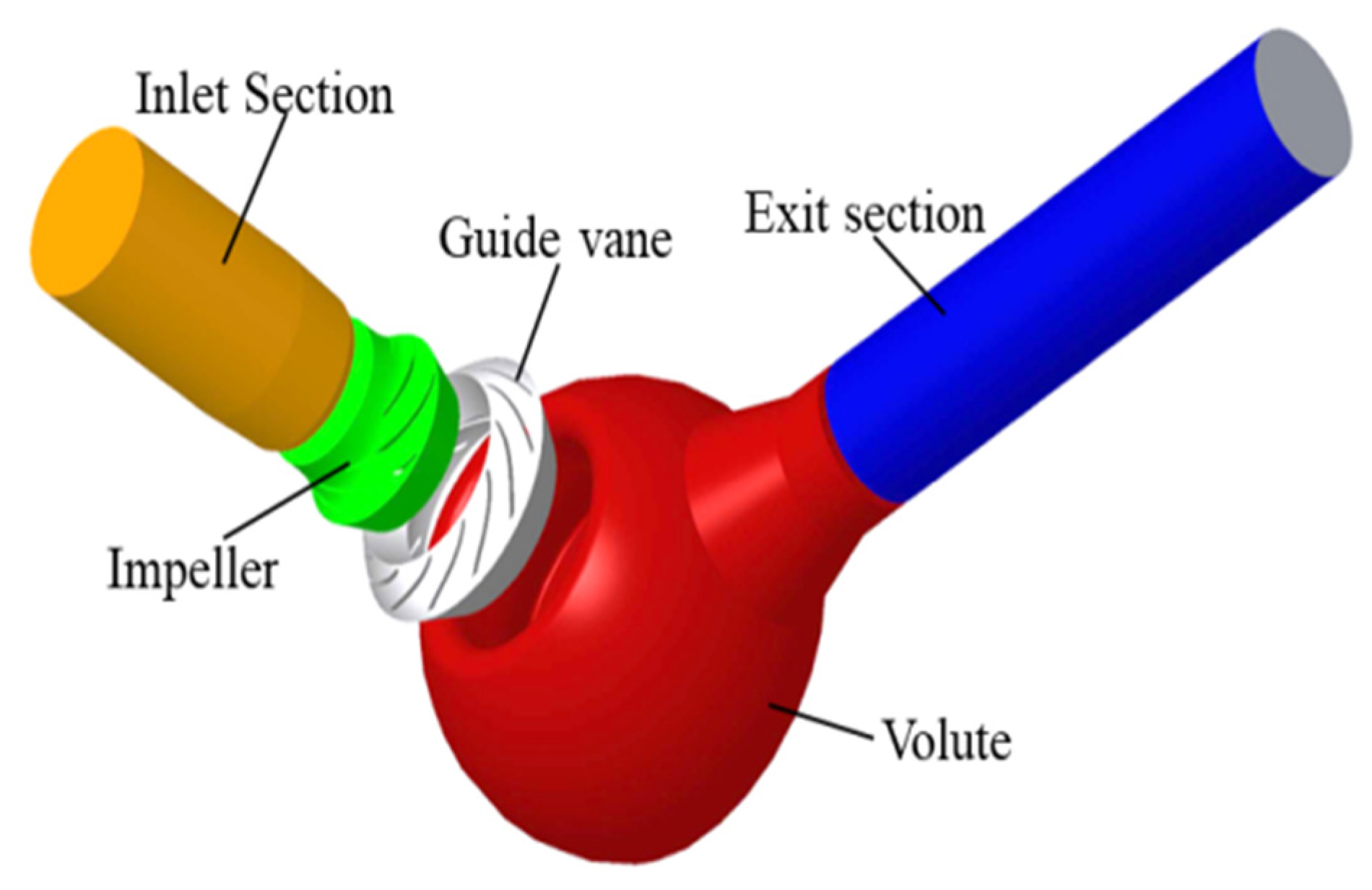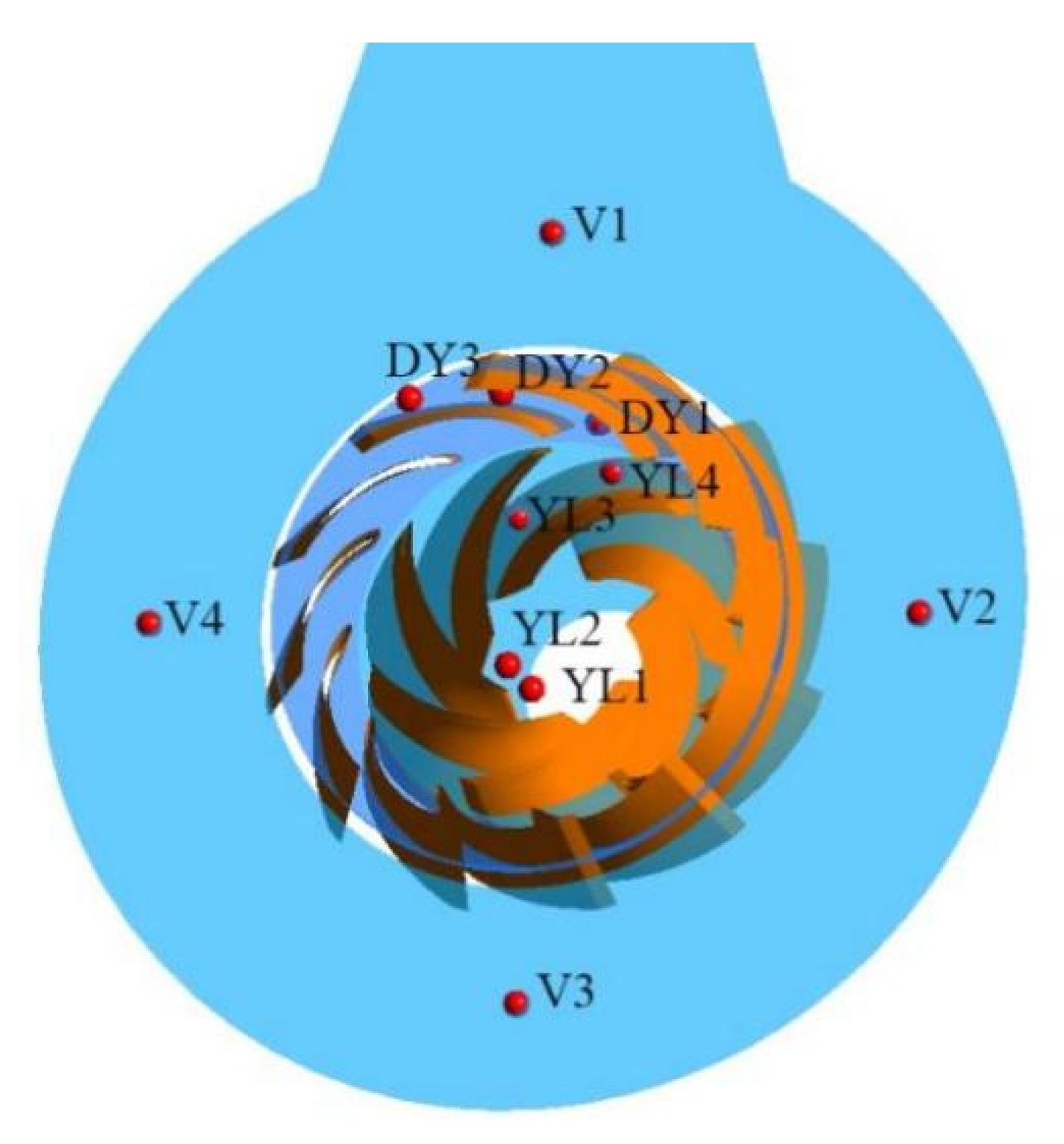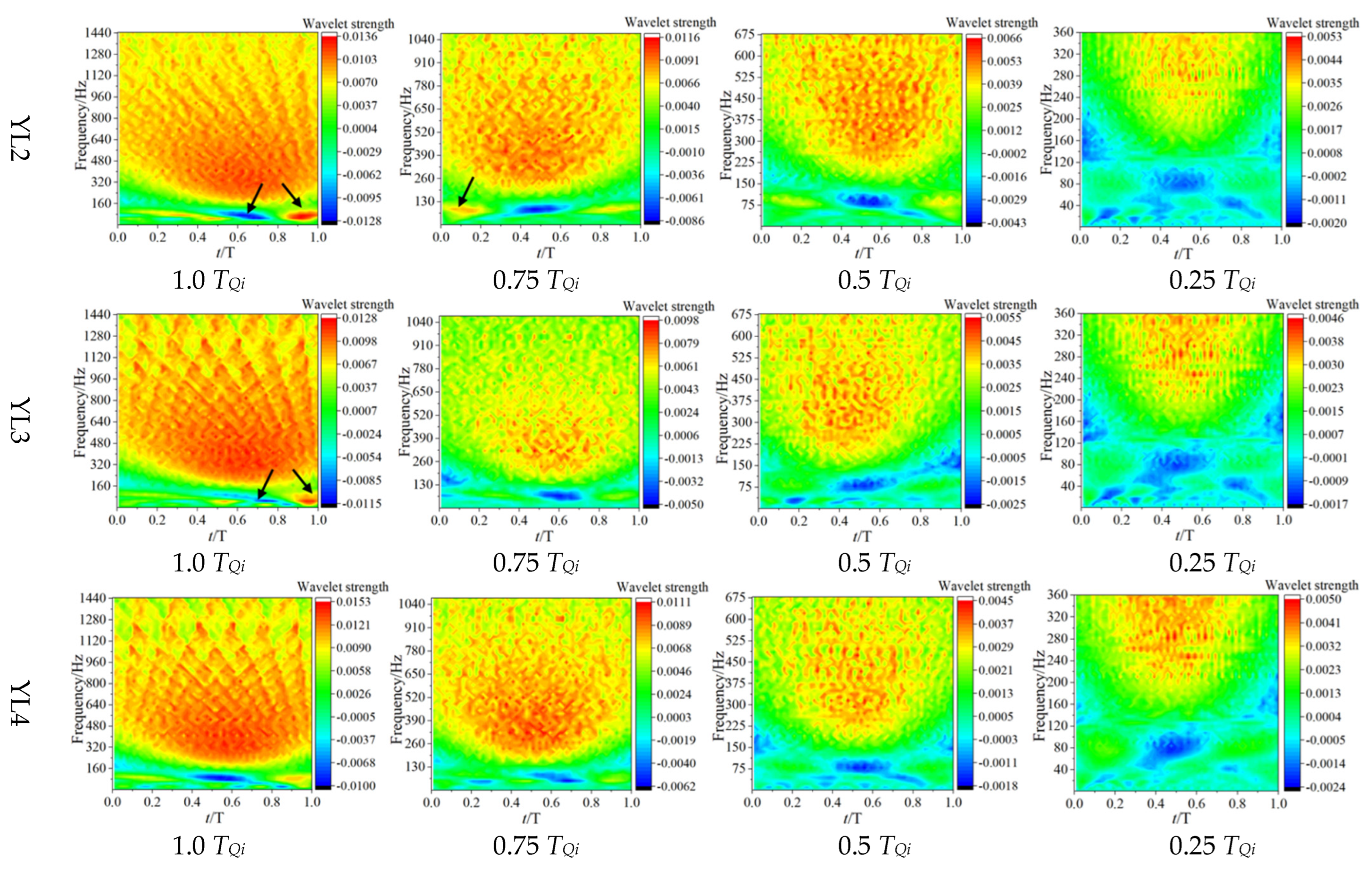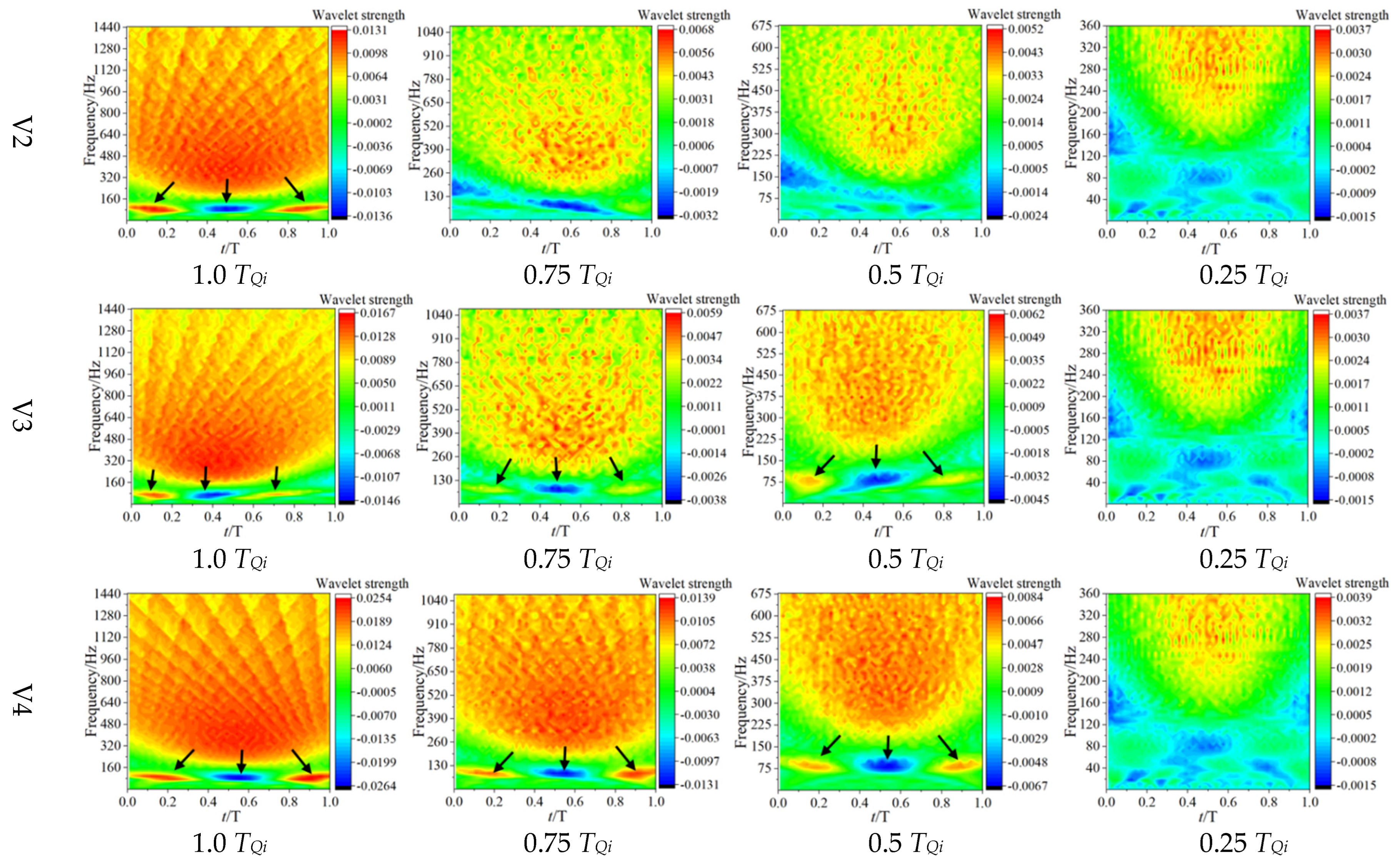Investigation of Unsteady Pressure Pulsations of Reactor Coolant Pump Passage under Flow Coast-down
Abstract
:1. Introduction
2. Research Methods
2.1. Research Objects
2.2. Meshing of Reactor Coolant Pump
2.3. Boundary Conditions
2.4. Monitor Points
2.5. Pressure Pulsation Analysis Methods
3. Results and Discussion
3.1. Pressure Pulsations in Impeller
3.2. Pressure Pulsations in Guide Vane
3.3. Pressure Pulsations in Volute
4. Conclusions
- (1)
- During flow coast-down from 1.0 TQi to 0.75 TQi, the change rate of the pressure ripple coefficient in the middle of the guide vane (DY2) and far from the outlet end of the pressure chamber (V3) is the largest, with the change rate greater than 50%. During the period from 0.75 TQi to 0.5 TQi, the change rate of the pressure fluctuation coefficient at the dynamic–static interface area is the largest (YL4, DY1), which is more than 60%. During the period from 0.5 TQi to 0.25 TQi, the change rate of the pressure fluctuation coefficient in the middle of the guide vane (DY2) is the largest, which reaches 68.69%. As the development of flow coast-down proceeds, the high-frequency pulsation decreases, the low-frequency pulsation increases, and finally the pressure pulsation tends to a smaller stable value.
- (2)
- In each flow passage, the wavelet intensity of YL4 at the impeller outlet, at the inlet of the guide vane (DY1), and at the left side of the pressurized water chamber (V4) changes strongly, while that at the impeller inlet (YL1), at the guide vane outlet (DY3), and at the tongue-separating area of the pressurized water chamber outlet (V1) changes smoothly. The occurrence of flow coast-down proceeding will cause a dramatic change in the pressure pulsation in the inner flow channel of the RCP and enhance the transient pressure pulsation.
- (3)
- The initial stage of flow coast-down, the high-frequency pressure pulsation in most areas of the inner passage of the RCP, still has obvious regularity, in which the regularity of the wavelet response of the guide vane passage is the strongest. There is a strong correlation between the pressure pulsation regularity in the passage and the number of impeller blades.
Author Contributions
Funding
Data Availability Statement
Conflicts of Interest
References
- Lei, M.K.; Li, M.Q. Research progress on basic theoretical issues of reactor coolant pump manufacturing. China Nucl. Power 2018, 11, 51–58. [Google Scholar]
- Ye, D.X.; Liu, A.L.; Luo, Y.M. Progress in research on pressure pulsation of reactor coolant pump and its improvement methods. J. Drain. Irrig. Mech. Eng. 2021, 39, 770–776. [Google Scholar]
- Ji, X.; Dai, Y.S.; Wu, Y.X. HPR1000: Advanced Pressurized Water Reactor with Active and Passive Safety. Engineering 2016, 2, 79–87. [Google Scholar]
- Wang, X.L. Study on Transient Hydraulic Characteristics of Multiphase Flow in Nuclear Main Pump. Ph.D. Thesis, Jiangsu University, Jiangsu, China, 2013. [Google Scholar]
- Zheng, C. Optimization of Nonlinear Idling Model Characteristics of Reactor Coolant Pump under Accident Conditions. Master’s Thesis, Jiangsu University, Jiangsu, China, 2018. [Google Scholar]
- Song, Y.; Gu, X.Y.; Liu, Y.Y. Numerical simulation of pressure pulsation performance of reactor coolant pump under different boundary conditions. J. Drain. Irrig. Mach. Eng. 2019, 37, 645–649. [Google Scholar]
- Zhu, Y.; Yin, J.L.; Zhang, J.G.; Wang, D.Z.; Cheng, H. Characteristics of pressure pulsation at inlet and outlet of shielded reactor coolant pump. Nucl. Technol. 2013, 36, 61–67. [Google Scholar]
- Yuan, S.Q. Discussion on design method of pump with large discharge. J. Irrig. Drain. Mach. Eng. 1988, 1, 7–11. [Google Scholar]
- Si, Q.R. Low Noise Hydraulic Design of Centrifugal Pump and Research on Dynamic-Static Interference Mechanism. Ph.D. Thesis, Jiangsu University, Jiangsu, China, 2014. [Google Scholar]
- Peter, D.; Milham, S.; Andre, K. Flow-Induced Pulsation and Vibration in Hydraulic Machinery; Jiangsu University Press: Zhenjiang, China, 2015. [Google Scholar]
- Lai, X.D.; Ye, D.X.; Chen, X.M. Pressure pulsation characteristics of mixed-flow reactor coolant pump in a spherical pressure chamber. Chin. J. Power Eng. 2020, 40, 169–176. [Google Scholar]
- Li, J.Y.; Lai, X.D.; Zhang, X. Analysis of pressure pulsation characteristics in mixed flow reactor coolant pump. Therm. Energy Power Eng. 2016, 31, 92–97. [Google Scholar]
- Dan, N.; Yang, M.; Bo, G. Experimental and numerical investigation on the pressure pulsation and instantaneous flow structure in a nuclear reactor coolant pump. Nucl. Eng. Des. 2018, 337, 261–270. [Google Scholar]
- Zhu, R.S.; Long, Y.; Fu, Q. Pressure pulsation characteristics of reactor coolant pump under low flow conditions. Vib. Shock 2014, 33, 143–149. [Google Scholar]
- Long, Y.; Wang, D.; Yin, J. Experimental investigation on the unsteady pressure pulsation of reactor coolant pumps with non-uniform inflow. Ann. Nucl. Energy 2017, 110, 501–510. [Google Scholar] [CrossRef]
- Ni, D.; Yang, M.G.; Gao, B. Correlation analysis of flow structure and pressure pulsation characteristics in mixed flow reactor coolant pump. J. Eng. Thermophys. 2017, 38, 1676–1682. [Google Scholar]
- Wang, P.; Yuan, S.Q.; Wang, X.L. Analysis of internal instability of reactor coolant pump under high flow condition. Vib. Shock 2015, 34, 196–201. [Google Scholar]
- Xu, Y.M.; Xu, S.M. Comparison of calculation models for flow coastdown speed of reactor coolant pump. Power Gener. Equip. 2011, 25, 236–238. [Google Scholar]
- Qiu, W.F.; Zhu, R.S.; Wang, X.L. Influence of optimization of impeller geometric parameters on flow coastdown characteristics of reactor coolant pump. J. Drain. Irrig. Mach. Engin. 2019, 37, 1019–1024. [Google Scholar]
- Ye, D.X.; Lai, X.D.; Wen, H.G. Research on performance characteristics of reactor coolant pump during power-off and flow coastdown shutdown transition process. Chin. J. Power Eng. 2020, 40, 593–599. [Google Scholar]
- Hu, X.D.; Wang, X.Y.; Liu, Z.L. Research on the accuracy of numerical simulation based on the performance prediction of Reactor coolant pump. Nucl. Power Eng. 2019, 40, 127–133. [Google Scholar]
- Wang, X.L.; Lu, Y.G.; Zhu, R.S. Study on the transient evolution law of internal flow field and dynamic stress of reactor coolant pump under rotor seizure accident. Ann. Nucl. Energy 2019, 133, 35–45. [Google Scholar] [CrossRef]
- Wang, X.L.; Lu, Y.G.; Zhu, R.S. Experimental study on transient characteristics of reactor coolant pump under rotor seizure accident. Ann. Nucl. Energy 2020, 136, 107039. [Google Scholar] [CrossRef]
- Zhou, Q.; Li, H.K. Study on pressure pulsation at the inlet of guide vane of centrifugal pump. J. Eng. Thermophys. 2020, 41, 1679–1684. [Google Scholar]
- Wang, K.L. Research on Cavitation and Pressure Pulsation Characteristics of High Specific Speed Centrifugal Pump. Master’s Thesis, Jiangsu University, Jiangsu, China, 2020. [Google Scholar]
- Pavesi, G.; Cavazzini, G.; Ardizzon, G. Time–frequency characterization of the unsteady phenomena in a centrifugal pump. Int. J. Heat Fluid Flow 2008, 29, 1527–1540. [Google Scholar] [CrossRef]
- Braun, O.; Ruchonnet, N. Analysis of pressure pulsation during the fast transition of a pump turbine from pumping to generating mode. J. Phys. Conf. Ser. 2017, 813, 012017. [Google Scholar] [CrossRef] [Green Version]
- Lilly, J.M.; Olhede, S.C. Generalized Morse Wavelets as a Superfamily of Analytic Wavelets. IEEE Trans. Signal Process. 2012, 60, 6036–6041. [Google Scholar] [CrossRef]
- Long, Y.; Wang, D.Z.; Yin, J.L. Numerical investigation on the unsteady characteristics of reactor coolant pumps with non-uniform inflow. Nucl. Eng. Des. 2017, 320, 65–76. [Google Scholar]
- Cheng, X.R.; Bao, W.R.; Fu, L. Steady state characteristics of internal flow in the annular pressurized water chamber of the nuclear coolant pump. J. Lanzhou Univ. Technol. 2019, 45, 49–56. [Google Scholar]

















| Main Parameters | Specific Value |
|---|---|
| Number of impeller blades | 7 |
| Number of guide vanes | 12 |
| Design flow rate, Q0 | 23,790 m3/h |
| Design head, H | 98 m |
| Speed, n | 1485 rpm |
| Operation temperature, T | 293 °C |
| Kinematic viscosity | 8.93 × 10−7 m2/s |
| Thermal kinematic viscosity | 9.42 × 10−8 m2/s |
Disclaimer/Publisher’s Note: The statements, opinions and data contained in all publications are solely those of the individual author(s) and contributor(s) and not of MDPI and/or the editor(s). MDPI and/or the editor(s) disclaim responsibility for any injury to people or property resulting from any ideas, methods, instructions or products referred to in the content. |
© 2023 by the authors. Licensee MDPI, Basel, Switzerland. This article is an open access article distributed under the terms and conditions of the Creative Commons Attribution (CC BY) license (https://creativecommons.org/licenses/by/4.0/).
Share and Cite
Ye, D.; Wu, J.; Liu, A.; Chen, J.; Zhai, F.; Lai, X. Investigation of Unsteady Pressure Pulsations of Reactor Coolant Pump Passage under Flow Coast-down. Machines 2023, 11, 55. https://doi.org/10.3390/machines11010055
Ye D, Wu J, Liu A, Chen J, Zhai F, Lai X. Investigation of Unsteady Pressure Pulsations of Reactor Coolant Pump Passage under Flow Coast-down. Machines. 2023; 11(1):55. https://doi.org/10.3390/machines11010055
Chicago/Turabian StyleYe, Daoxing, Jinchen Wu, Anlin Liu, Junlin Chen, Fengli Zhai, and Xide Lai. 2023. "Investigation of Unsteady Pressure Pulsations of Reactor Coolant Pump Passage under Flow Coast-down" Machines 11, no. 1: 55. https://doi.org/10.3390/machines11010055
APA StyleYe, D., Wu, J., Liu, A., Chen, J., Zhai, F., & Lai, X. (2023). Investigation of Unsteady Pressure Pulsations of Reactor Coolant Pump Passage under Flow Coast-down. Machines, 11(1), 55. https://doi.org/10.3390/machines11010055






